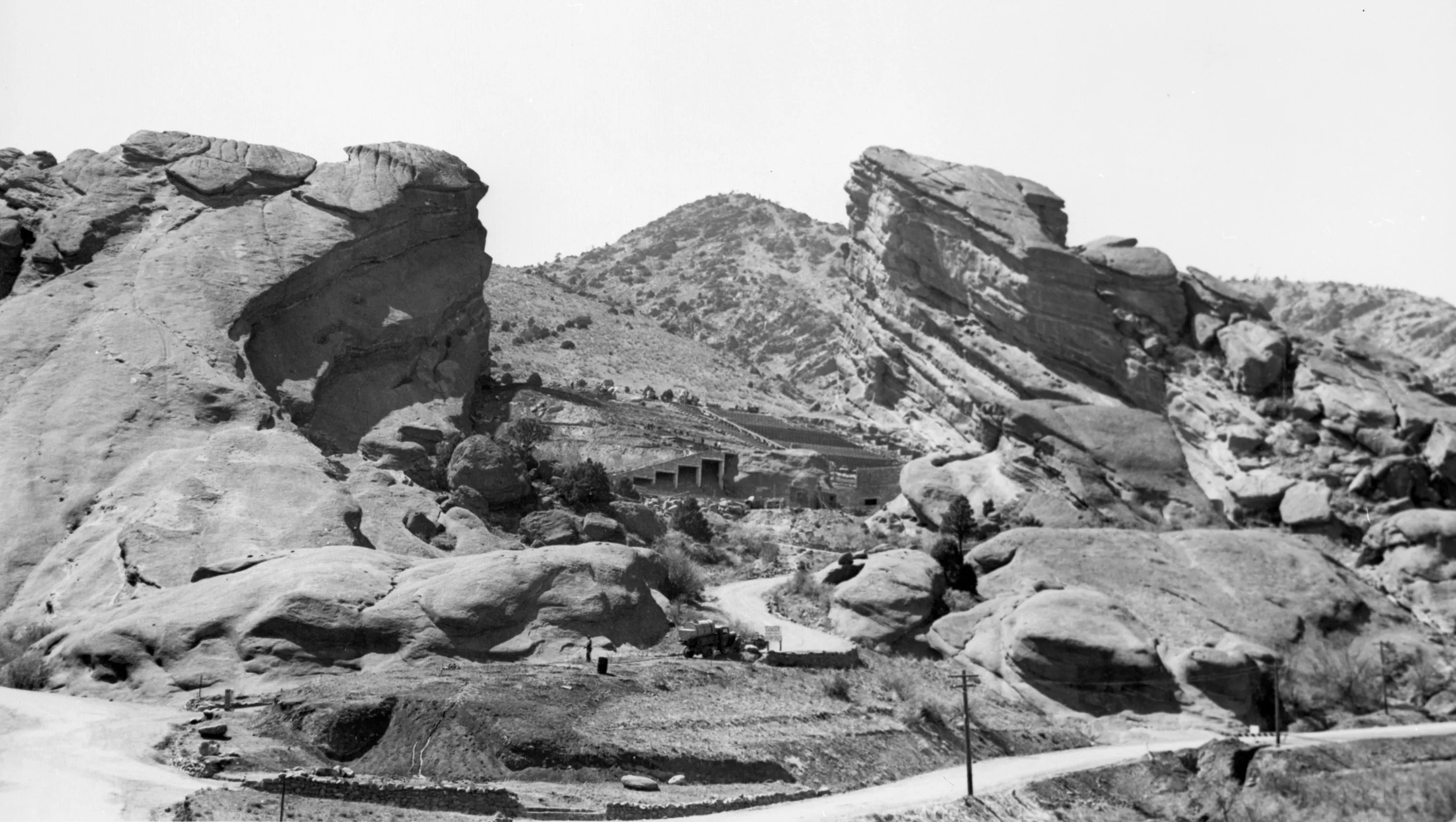
Denver Arts & Venues

Audio By Carbonatix
Tear gas filled the air, and people scrambled over bodies to get out. The ground was coated with broken glass, along with blood and trash. Helicopters swept low over the crowds, dropping even stronger gas in an effort to restrain the mob. People were fainting from a lack of oxygen, and mothers were rushing to find medics to provide care for their babies.
It wasn’t a war: It was a riot at the Jethro Tull concert at Red Rocks Amphitheatre on June 10, 1971.
When frontman Ian Anderson was finally able to take the stage, he joked, “Welcome to World War Three,” and the audience members who remained laughed. The show went on, and afterward, Anderson explained his decision to perform: “Well, the embarrassment of stopping is far worse than the mild pain of having a bit of tear gas down your lungs.”
That show is distant history now, but such wild-and-woolly rock legends are as well preserved at Red Rocks as the fossils baked into the venue’s grounds. And Red Rocks, one of Colorado’s best-known landmarks, has many more stories to crack open.
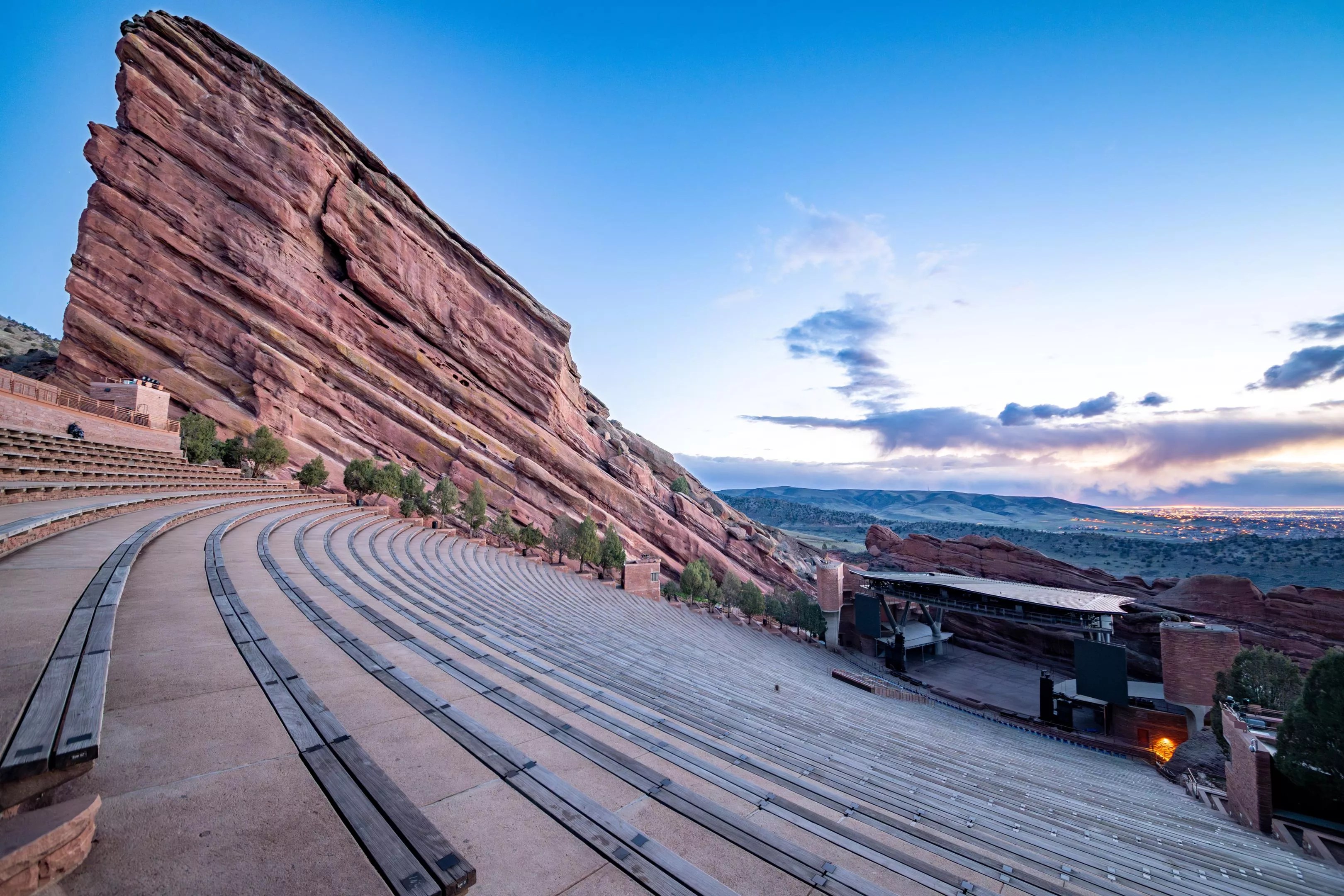
Red Rocks before the crowds.
Ross Jones
The Rise of Red Rocks
A sunrise in the Rocky Mountains is always profound, but especially from this perch at the edge of the Front Range. As the sun begins its ascent over the Eastern Plains, rays crawl across the silhouette of downtown Denver before slipping over the crest of Morrison’s Dakota Hogback, the cascading ridge that emerged from a shallow sea 50 million years ago, marked by dinosaur footprints from 100 million years before that. And then, a color bomb: The famous sandstone rocks just to the west are aglow, illuminating the majestic umber color and noble stature of the unmistakable natural wonder that became Red Rocks Amphitheatre.
The sunsets aren’t bad here, either, with live music blasting from the stage as the city lights twinkle against lavender clouds. Perfectly poised for all that it offers – whether that’s catching a concert, seeing a film, taking a yoga class or hiking one of the many trails around its 738 acres – Red Rocks is the kind of place that reminds us that life itself is an immeasurable gift.
“This is not like other venues,” says Brian Kitts, the communications director for Denver Arts & Venues, which operates the city-owned amphitheater. Standing in the back garden of the Trading Post gift shop, he gestures toward the valley views, dotted by heaps of red sandstone that give way to the mountain range beyond. “It’s very rustic. … There are rattlesnakes, there are skunks, there are raccoons and mountain lions and lynx. At yoga early in the morning, a deer will casually stroll through. You don’t get that at Ball Arena.”
Or at most other music venues, for that matter. Artists who play Red Rocks speak of the venue’s seductiveness, a captivating pull that underscores the thrill of taking the stage and gazing at a crowd framed by rocks that are 300 feet high (that’s almost double the height of Niagara Falls). Before his band’s anniversary show in 2023, Bill Nershi of the String Cheese Incident told Westword that the first fifteen times he played Red Rocks, he was “pretty overwhelmed.”
“It’s not just because it’s Red Rocks, but the way that amphitheater is set up,” he explained. “You’re at the bottom of this kind of funnel with these rock sandstone walls reaching up on each side. All the energy is funneling down to you, like, ‘Okay, we’re here now, what are you going to do to impress us?’ and you’re like, ‘Oh, shit.'”
Audiences feel that energy, too, and many visitors to the state come specifically to see a show at Red Rocks – or just Red Rocks itself. Kitts notes that the venue welcomes up to a million tourists each year: “It’s the number-one free and paid tourist attraction in the state and most Instagrammed location.
“On any given night, we’re going to have between 25 and 30 percent of our audience from out of state,” he continues. “That’s a big number coming in specifically for a show at Red Rocks. And so that’s where you realize that this is not only a terrific jewel for the Denver metro area, but it’s also a bucket-list visit for a lot of music fans.”
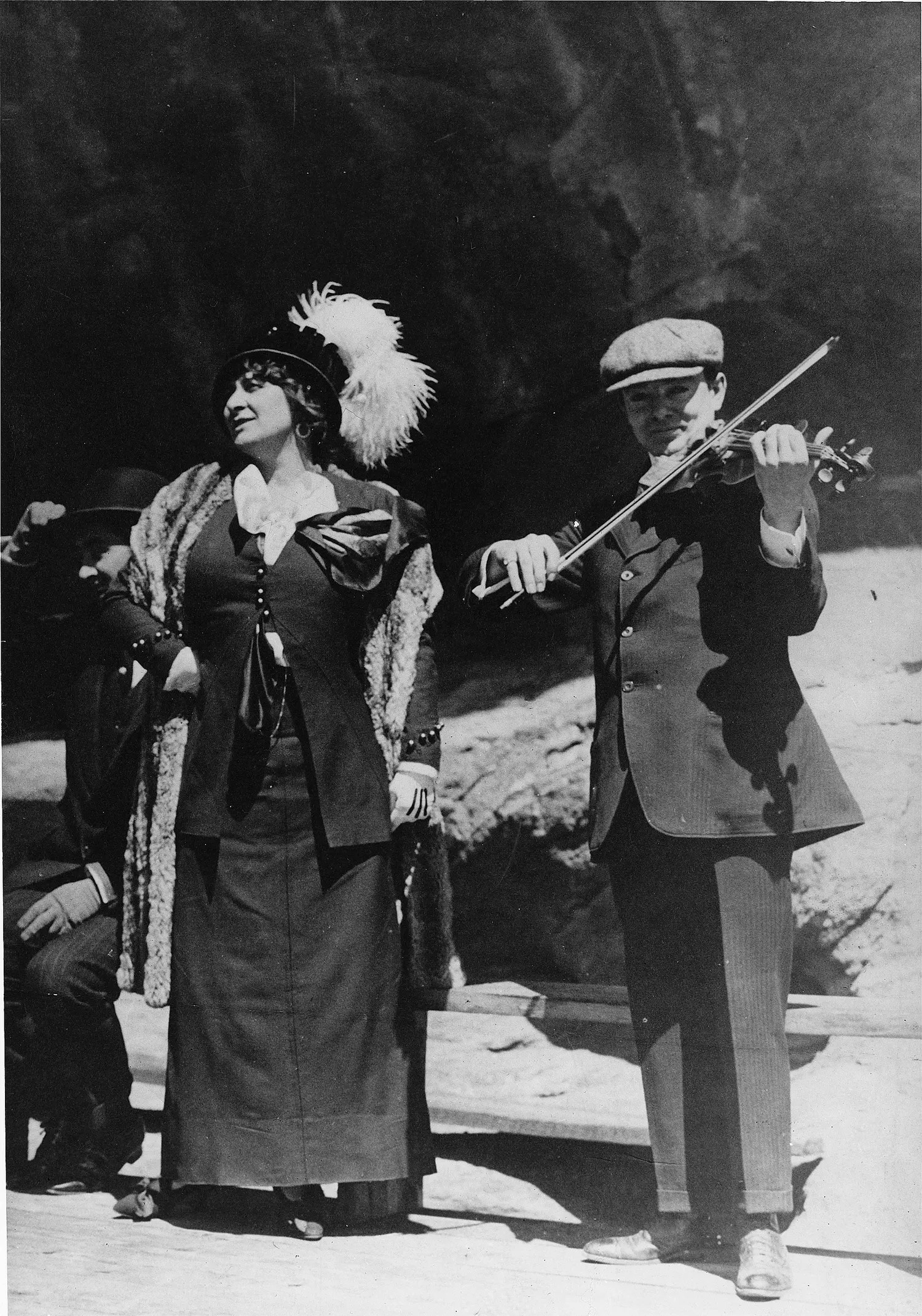
The famed Scottish opera singer Mary Garden played the first solo show at Red Rocks.
Denver Arts & Venues
COVID still hit the venue hard in 2020. Employees were furloughed by the city, and when concerts did return, there was a highly limited capacity, with artists such as Nathaniel Rateliff playing to just 250 guests. But Red Rocks bounced back: The year after the pandemic struck, it was the most-attended venue in the world, and this past December, Billboard reported that Red Rocks was the most-attended outdoor venue in the U.S. and the fourth-most-attended in the world.
And despite urban myths that question its resilience – we’ve all had a wook wrapped in pashmina scarves relay the rumor that the bass from EDM is degrading the rocks – Red Rocks isn’t going anywhere. In fact, the rocks absorb the sound, which is what makes the venue unparalleled for its superior acoustics. After the first solo performance at Red Rocks, in 1911, Scottish opera singer Mary Garden declared: “Never in any opera house the world over have I found more perfect acoustic properties than those under Creation Rock in the natural auditorium at Mount Morrison.”
“This place is 300 million years in the making. The sound is so good because the sandstone that makes up those monoliths absorbs [it],” Kitts explains. “In an arena, the cement and glass and everything bounce the sound around. But this is a naturally occurring amphitheater. And the Native Americans were doing performances here of their own, obviously, for a long time. People in Denver figured it out. There were big boulders that had to be blasted and carried out by train, but otherwise, it was already in place. I think that’s Denver’s good luck: It just happened to be there.”
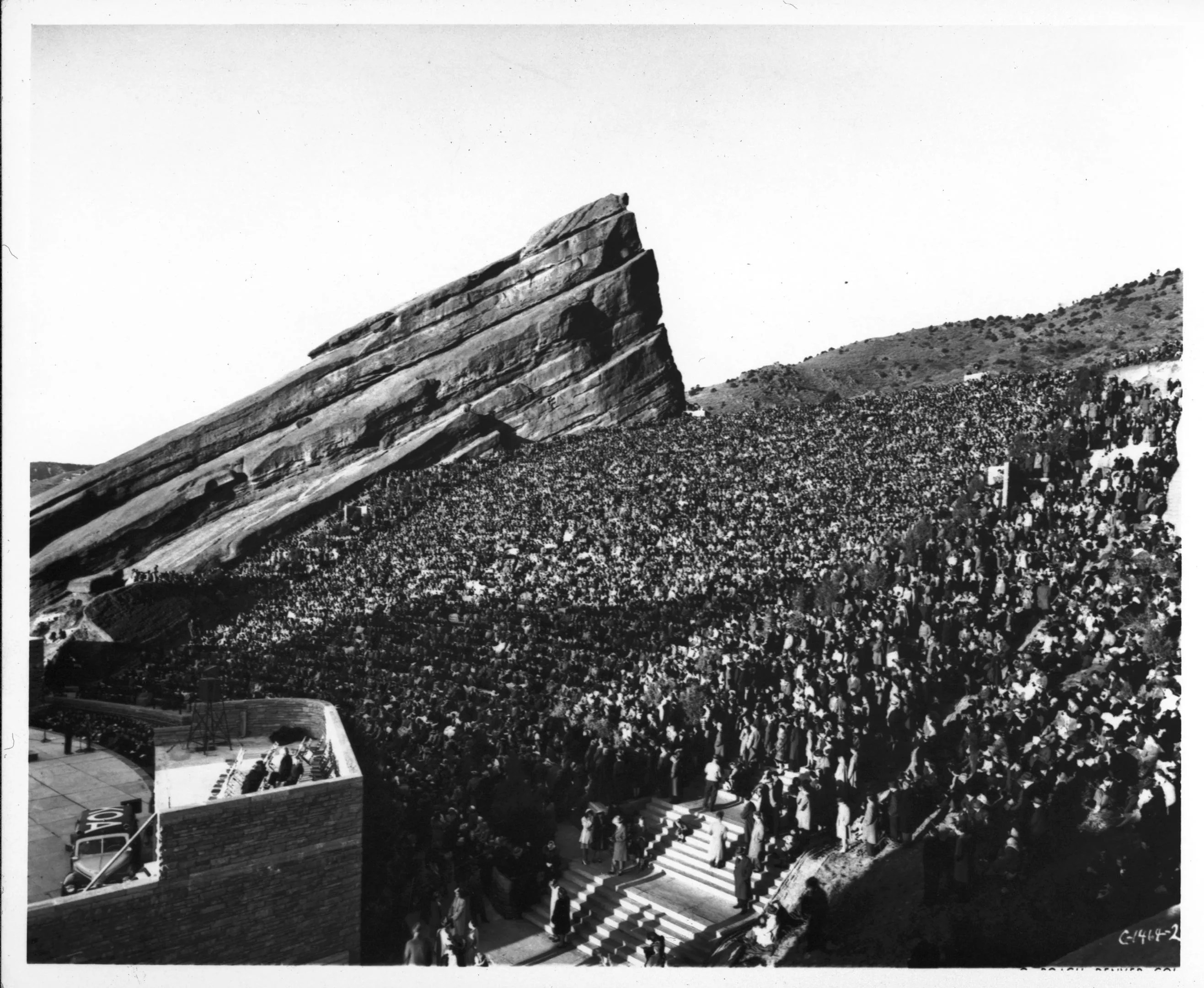
Red Rocks has drawn sold-out crowds since its inception — just take a look at its grand opening here.
Denver Arts & Venues
In the Beginning…
Before it was transformed into the amphitheater it is today, Red Rocks was a sacred site for the various Ute tribes, which had occupied the area for centuries before the Cheyenne and Arapaho moved in during the early 1800s. It was during that period that Colorow, a future Ute Mountain Utes sub-chief, was born in northern New Mexico as a Comanche. Kidnapped by Utes as a child, he came to Colorado and went on to lead battles for land against the Arapaho and Cheyenne in the future locations of Aspen and Golden, as well as against fortune seekers arriving during the Rush to the Rockies, after gold was discovered at the confluence of Cherry Creek and the South Platte in 1858.
But he maintained peaceful connections with some settlers, particularly in Morrison. The ponderosa pine under which Colorow hosted tribal councils, called the Inspirational Tree or Council Tree, still stands at the foot of Dinosaur Ridge northeast of Red Rocks; it was placed on the National Register of Historic Places in 1975. During times of turmoil, he would take refuge at both Red Rocks and a cave to the south, now called Colorow’s Cave or the Willowbrook Amphitheater.
The people who joined in the Gold Rush didn’t all head for the hills. The first territorial governor of Colorado, Robert W. Steele, built his mansion just six miles from Red Rocks, where newcomers were awestruck by the rocky grounds.
In 1870, six years before Colorado gained statehood, Red Rocks was christened the Garden of Angels by Jefferson County judge Martin Van Buren Luther. The first recorded owner was Marion Burts, who purchased the land in 1872 and sold it six years later to a railroad engineer out of Pennsylvania, Leonard H. Eicholtz. He transformed it into a park, adding roads and trails that are still climbed today, before selling it to magazine editor John Brisben Walker in 1905 for a mere $5,000. (That’s just $180,000 in today’s figures; try finding a house for that, much less acres of land.) The surrounding area had been bustling for decades at that point, with stonemason George Morrison opening quarries and transporting the red sandstone seen in many Colorado landmark buildings, including the Capitol.
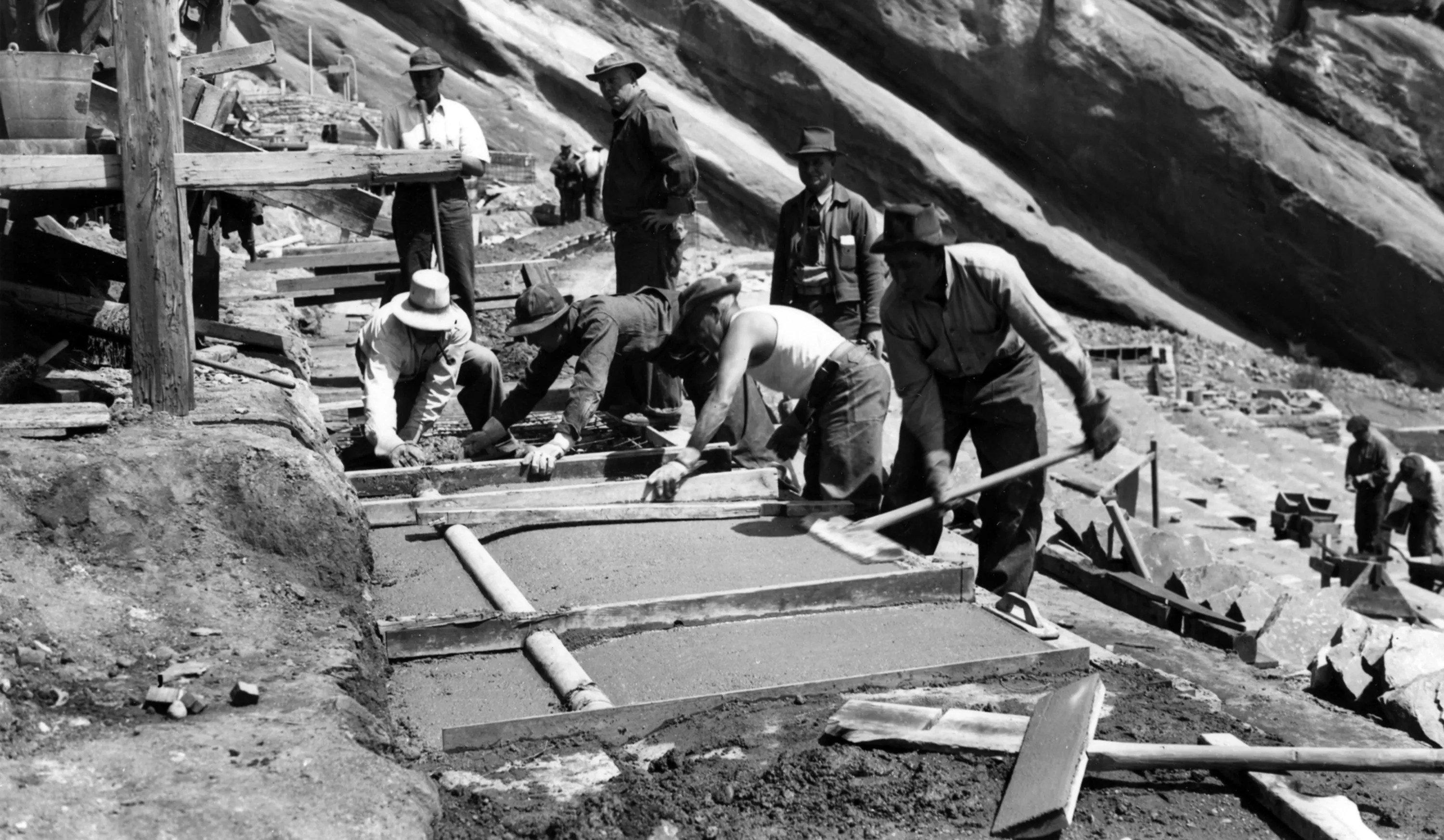
Construction began in 1936 through the Civilian Concervation Corps and the Works Progress Administration.
Denver Arts & Venues
Walker had been in Colorado since the 1880s and donated the forty acres that comprise Regis University today. But he wanted to keep this land: He had a vision of creating a stage between the two soaring rocks, named Ship Rock and Creation Rock. His other, more wacky vision? Locating that stage in an amusement park. He and his son renamed the grounds the Garden of Titans and created the Mount Morrison Railway Company to promote it, taking tourists up the mountain. (Its path is now partially traced by the Funicular Trail at Red Rocks.)
The first official Red Rocks concert was held at the Garden of Titans’ grand opening on May 31, 1906, showcasing Pietro Satriano and his 25-piece brass ensemble. A couple of years later, the largest concert in the venue’s history to date took place, an affair called the Feast of Lanterns, with four military bands and fireworks honoring the opening of a scenic road on Mount Falcon.
Not everyone was happy with Walker’s grandiose plans – which included carving a replica of the Sphinx as well as presidents’ faces into the rocks – and that led to the legend of the Hatchet Lady. While some visitors say they can hear the sound of drums from phantom Utes, the Hatchet Lady is by far the most famous resident ghost at Red Rocks, and is known for terrorizing ardent teens. Many accounts of “Old Mrs. Johnson” have proliferated online, but the most popular is that she lived at a ranch nearby and was very unnerved by Walker’s amusement park dreams. She made her abjuration clear by carrying a hatchet, terrifying workers as well as children.
But the Hatchet Lady – if there ever was one – couldn’t stop the inevitable. When Walker became strapped for cash, he sold the grounds to entrepreneur John Ross, whose brother, Harold, co-founded the New Yorker. Ross donated several hundred acres to the City of Denver, which went on to buy the rest of the park for a little over $50,000 in 1927. From then on, the venue was called Red Rocks Amphitheatre.
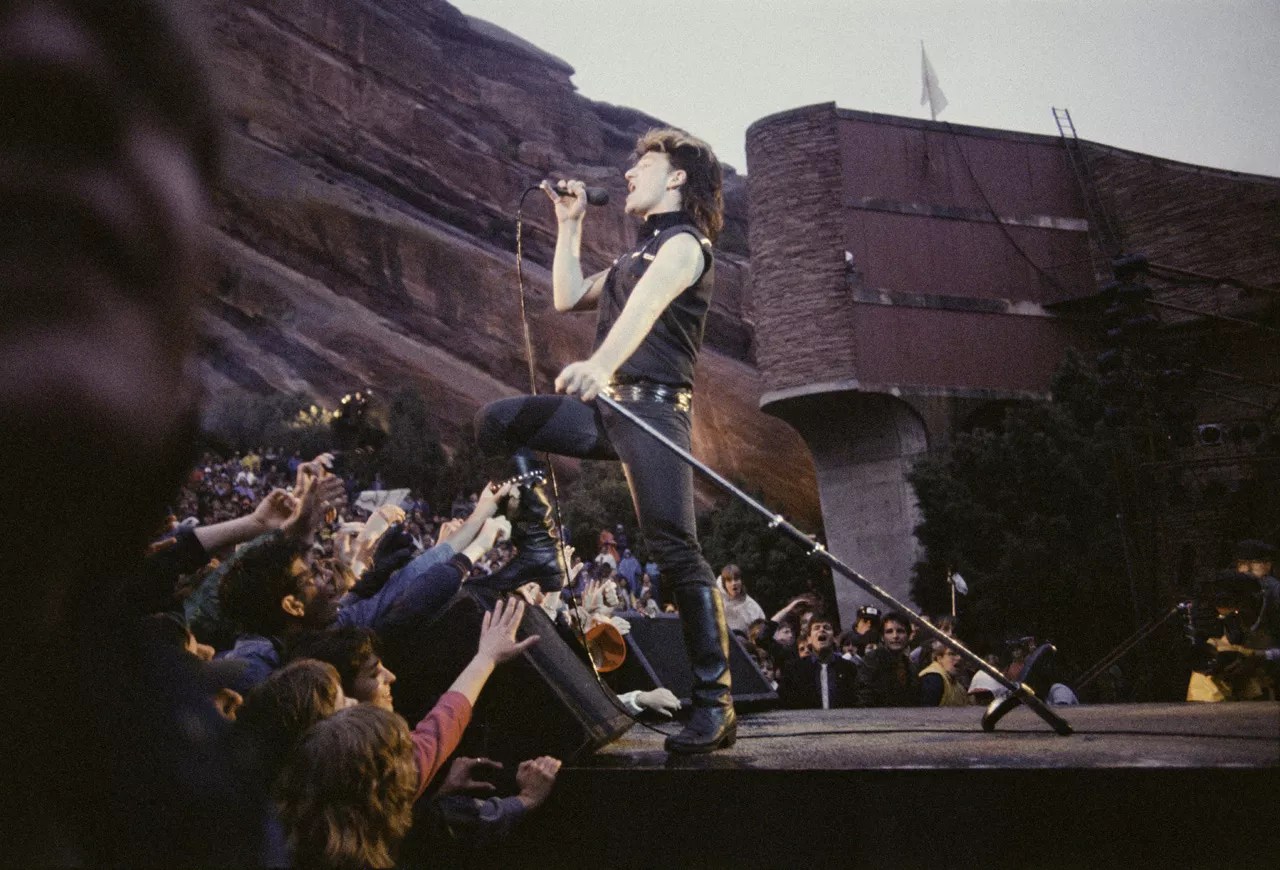
Bono performs at Red Rocks.
Denver Arts & Venues
Red Rocks Gets in Gear
As the automobile boom began, the city began building up the venue, adding a five-mile scenic road through the park in 1930 and erecting the Trading Post the next year, where visitors could buy ice cream for a nickel. But the venue’s construction really got revved up in 1936 through the Civilian Conservation Corps and the Works Progress Administration, both part of President Franklin Roosevelt’s New Deal. Camping on the property, young men who were previously unemployed worked tirelessly to create the infrastructure of the amphitheater, which was designed by architect Burnham Hoyt to emulate the Theatre of Dionysus in Athens. Around 200 workers were paid $1 a day to excavate the property, removing 25,000 cubic yards of rock by blasting it away, then landscaping the rest. Hoyt planned the amphitheater in stages, revising the master plan as he familiarized himself with the land.
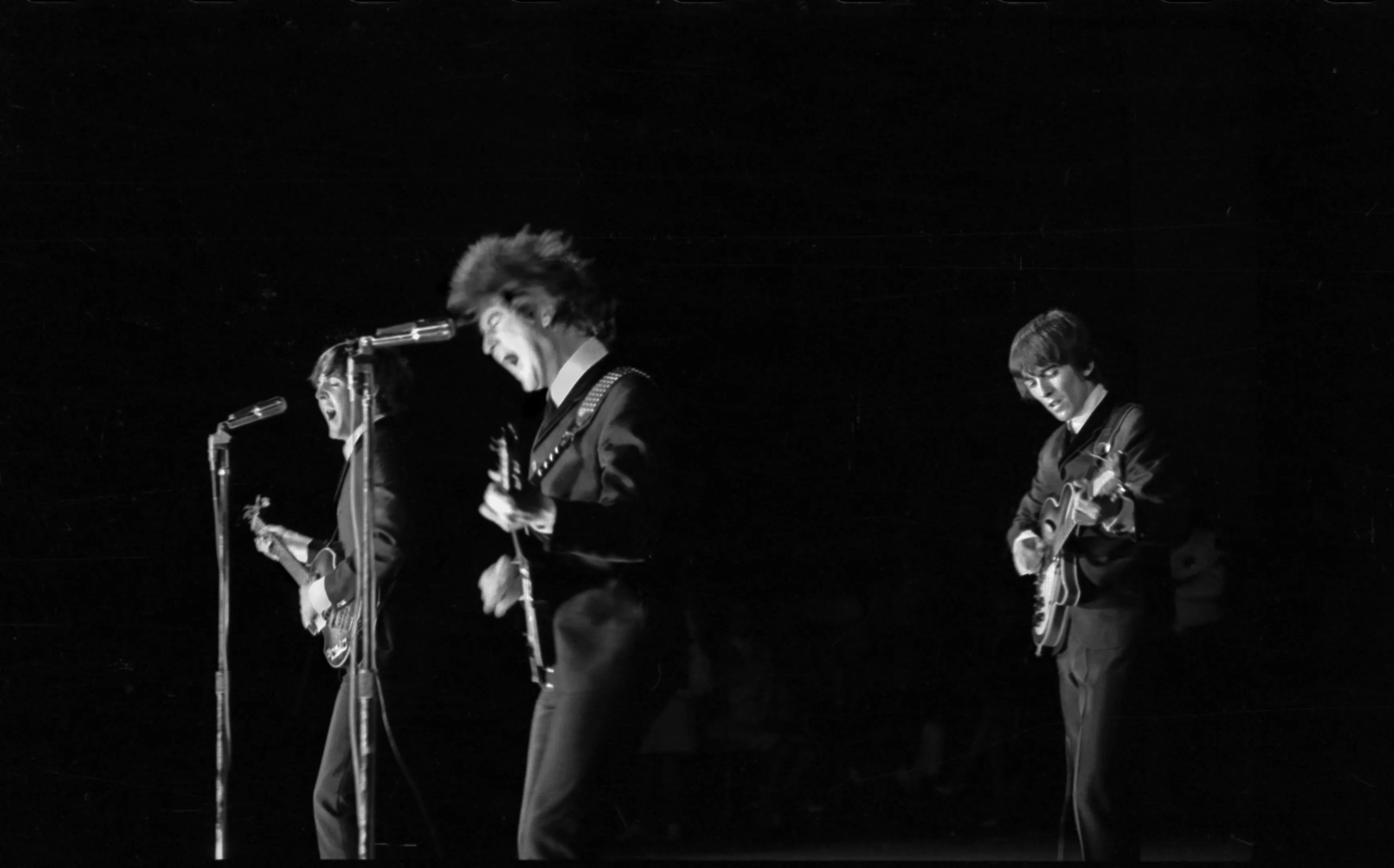
The Beatles played their first and only Colorado show at Red Rocks Amphitheatre.
Denver Arts & Venues
Red Rocks Amphitheatre – with a real stage and bench seating – officially opened on June 15, 1941, with a ceremony featuring Native Americans and a chorus singing operatic selections. Later, the venue would be filled with a different kind of music: rock and roll.
The Beatles were one of the first rock bands to play Red Rocks, on August 26, 1964. The band didn’t sell out the venue, though, managing just 7,000 tickets (at $6.60 a pop); it was the only show that didn’t sell out on the group’s first U.S. tour. It was also the first and the last time the Beatles played in Colorado – perhaps because the mop-topped lads from Liverpool required oxygen canisters on stage.
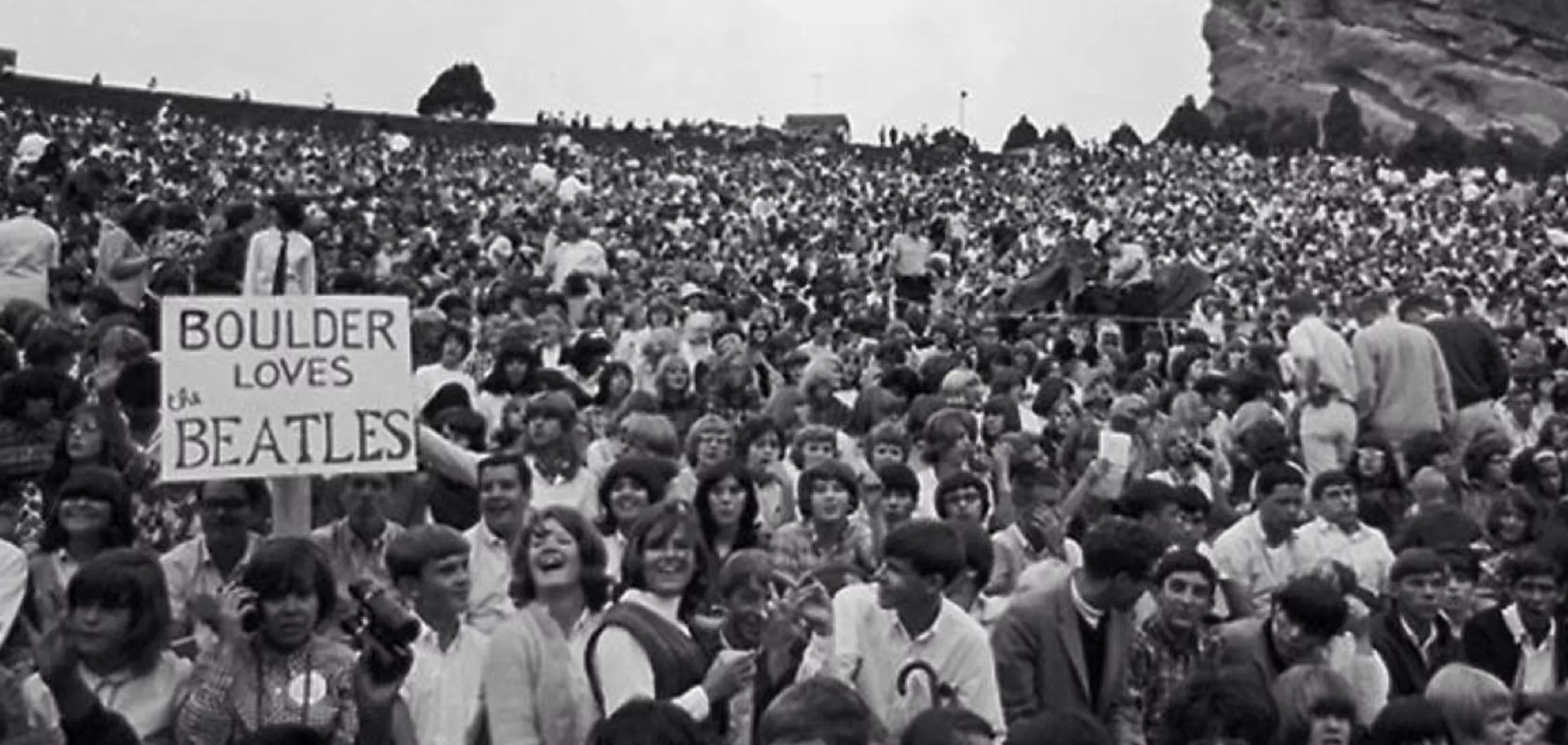
Denver Arts & Venues
But it didn’t mark the end of rock at Red Rocks, either. As promoter Barry Fey gained power, he brought in the country’s biggest bands, including the Jimi Hendrix Experience, which did sell out the venue with $5 tickets on September 1, 1968. (That same night, Hendrix is said to have written the lyrics for “Have You Even Been (to Electric Ladyland)” at the long-gone Cosmopolitan Hotel.) Also in 1968, Aretha Franklin refused to perform at Red Rocks because of a contract dispute, causing a riot. Fans stormed the stage, destroying a piano in the process, and rock and roll was banned from the venue for the entirety of 1969.
But that mob paled in comparison to the “not-so-pleasant evening with Jethro Tull,” as the Los Angeles Free Press called it. After that explosive affair in 1971, Mayor William McNichols banned rock music yet again, a decision that was overturned in 1975 by the courts after Fey sued the city. And that meant the Grateful Dead could grace the venue, playing a total of twenty shows there from 1978 through 1987.
It wasn’t until 1996 that another ban occurred, this time against Phish (who else?) after a four-night run, but that was mostly because of the jam band’s obsessive fans camping around Morrison. The Phish ban ended in 2009, when the group returned for another four-night run – an annual event that subsequently moved to Dick’s Sporting Goods Park.
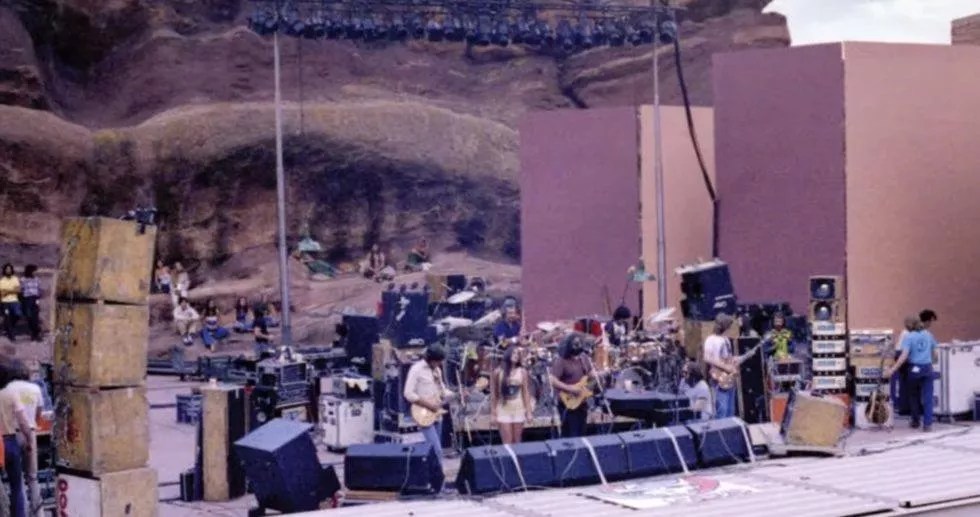
The Grateful Dead played Red Rocks for the first time in 1978.
Denver Arts & Venues
Red Rocks Today
More than eighty years after Red Rocks held its grand opening, much remains the same – its awe-inspiring beauty, its wildlife and its unbeatable acoustics. But there are always changes, even though they may be subtle. “We’re constantly trying to look at what improvements should be or could be made to improve the experience for people, as well as the aesthetics in the venue itself,” says Tad Bowman, who has been the venue’s director for almost thirty years, after starting as an intern in the marketing department. “But it’s very important to note that it’s done thoughtfully, not willy-nilly. It’s not just modernizing or making something that’s out of place from what [Red Rocks] is. It’s about keeping the character, the landmark status.”
Even though these changes are usually just upgrades to the infrastructure – such as lighting, paving or fencing for safety – the adjustments take time. Bowman notes that the new roofing for the stage was approved to begin construction in 2017 and was only just completed in 2021. But then, all construction is done during the off-season, from November through March.
The 2024 concert season kicked off with some additions already in place, including a paved road, sidewalks and sleek fencing by the Trading Post; new rails at the south ramp entrance; a streamlined security system; pergolas over porta-potties in some lots; the newly paved circular top; revamped bathrooms in the Visitors Center; and ADA-compliant shifts for the shuttle and parking in the upper south lot.
To accommodate changes at the Trading Post, the Colorado Music Hall of Fame, which had an exhibit in the space for eight years, left the building. “When we moved into Red Rocks Trading Post in 2016, that was all part of a partnership with the City of Denver,” says executive director Karen Radman. It was always a temporary agreement to have CMHOF at Red Rocks, which was a member of the first class inducted into it; the nonprofit now has another location in the works.
The 2025 season will see a revamped loading system behind the stage, which will be a relief for musicians. Such revisions are made possible by funds raised by Red Rocks itself. “We don’t take money from the mayor’s office as part of the general fund,” Kitts notes. “Red Rocks is a financial generator. It pays for itself and, in addition, pays for lots of other stuff that happens in Arts & Venues.”
Other stuff happens at Red Rocks, too. After a violent hailstorm during the June 21, 2023, Louis Tomlinson show garnered national headlines, with eighty people treated for injuries and seven taken to the hospital, some Red Rocks fans thought venue managers might rethink a weather policy. However, at an outdoor venue at the edge of the Rocky Mountains, changing conditions are par for the course. As Bowman puts it: “Weather is going to be something that happens.”
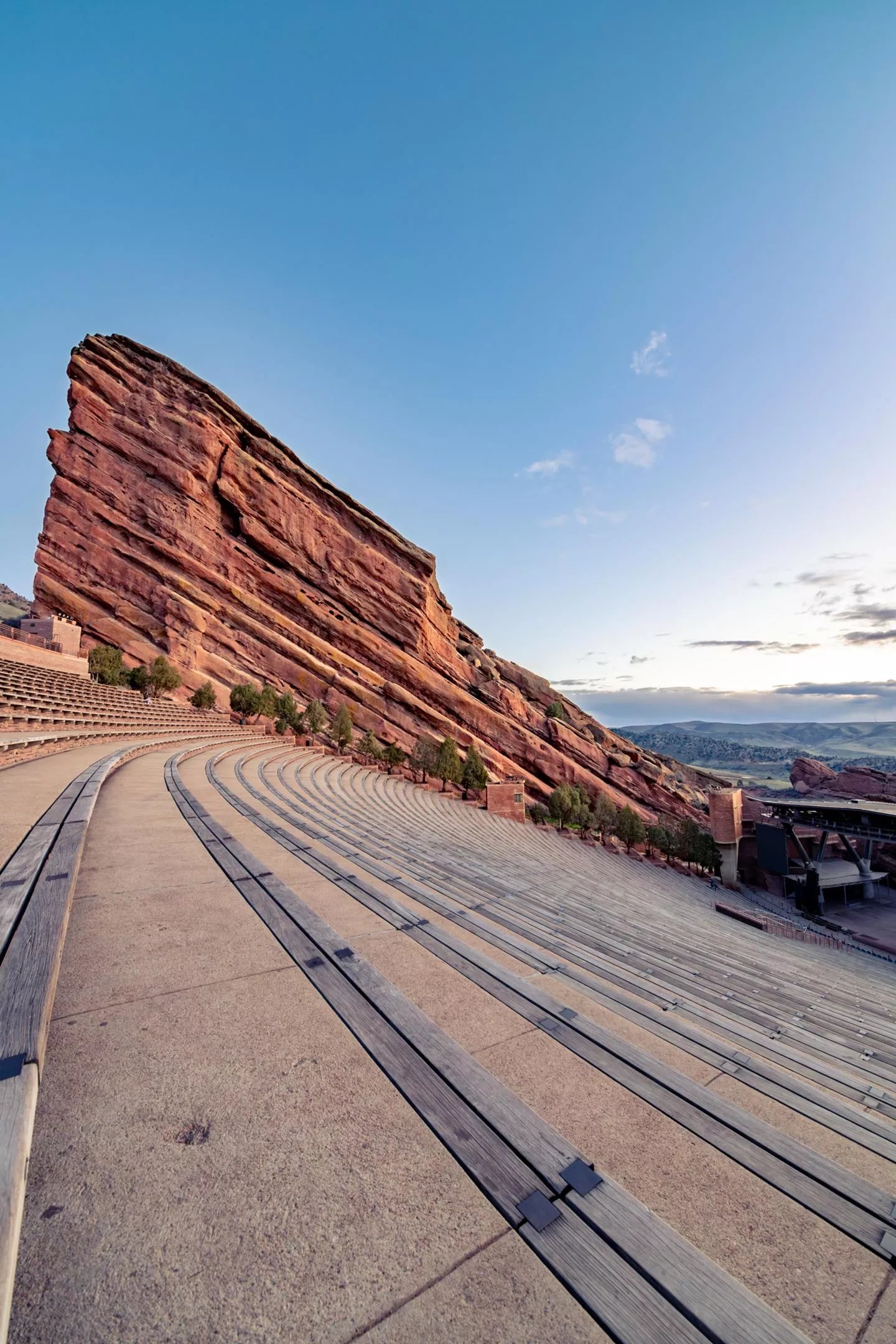
Ross Jones
The Future of Red Rocks
While the weather will always be up in the air, the volume of concerts is only going up. Kitts says that in the decade he’s worked for Arts & Venues, the lineup has gone from 75 ticketed events a year to more than 200, including Film on the Rocks, which began in 2000 through a partnership with Denver Film, and Yoga on the Rocks, which started in 2012. “Touring has changed so much,” he says. “You’re not going to make money just selling records; artists need to hit the road. And Red Rocks is cool. It’s in the middle of the country, and it’s a good, mid-sized venue. We don’t reach out to people; we have a mad scramble for dates when they open up.”
While its 9,525-person capacity makes it unlikely that artists like Beyoncé or Taylor Swift will play Red Rocks, that’s never stopped the venue from pulling in quality musicians as well as those with star power year after year. Some dates may as well be considered reserved for bands such as Blues Traveler, Big Head Todd and the Monsters, and Widespread Panic, whose concerts have become an annual affair.
Widespread has played Red Rocks the most, with seventy shows since its first in 1991, and most sell out. Not far behind is the String Cheese Incident, which celebrated its thirtieth anniversary and fiftieth Red Rocks run in 2023.
“We try to be careful when we work with the promoters on the schedule, because we want those folks who are here on a regular basis like those ones,” Bowman says, “but we also don’t want the same calendar every year.”
Booking “is mostly done by our major promoters, AEG and Live Nation, the Colorado Symphony, Awakening Events,” Kitts adds. “But the bottom line is that there are more acts out there than we have dates for, and that’s a really nice position to be in. The fact that it’s an iconic venue in a beautiful place in a beautiful state makes it a fun place to play.”
The venue pays tribute to the acclaimed artists who’ve performed there in the Red Rocks Performers Hall of Fame, which opened when the Visitors Center made its debut in 2003, with recent upgrades including band photos and memorabilia and new tech.

Bono performs at Red Rocks.
Denver Arts & Venues
And musicians get to see more history when they enter a tunnel below the stage that’s coated with signatures left by artists since the ’90s. Bowman remembers taking Yo-Yo Ma on a tour there years ago, before the world-renowned cellist was slated to play a concert. It was a Sunday morning, and tourists were ambling around the amphitheater when Ma decided to take out his cello and play a couple of songs on stage.
“He just played with a handful of tourists around,” Bowman recalls, “and then there were a couple of young guys that recognized him, and they started talking to him, and he was just chatting with them like they were old friends. It was just so cool.”
Whether they’re music or nature lovers or both, fans can always expect an unforgettable time when they visit Red Rocks.
So can the musicians. “We were doing some stuff for the 75th anniversary, and we were recording some of the artists that came through,” Bowman recalls. “Michael Franti said that the first time he came here, he said, ‘This place is so beautiful. I can’t believe they built a music venue here.’ And then he said to himself, ‘This place is so beautiful. Thank God they built a music venue here!'”
This story was originally published in April 2024. See more about Red Rocks at redrocksonline.com.